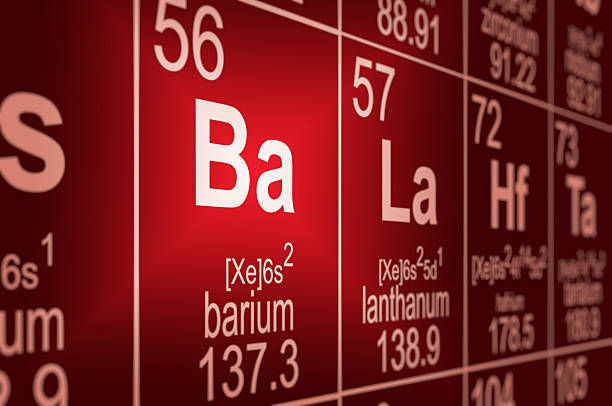Barium

Parameter Type: Drinking Water Testing for Volatiles
Parameter Name: Barium
What it is and Where it Comes From:
Barium is in the Periodic Table with the symbol Ba and atomic number 56. It is the fifth element in Group 2, a soft silvery metallic alkaline earth metal. Barium is a lustrous, machinable metal which exists in nature only in ores containing mixtures of elements. Because of its high chemical reactivity, barium is never found in nature as a free element. It is used in making a wide variety of electronic components, in metal alloys, bleaches, dyes, fireworks, ceramics and glass. Barium can suggest the presence of industrial waste, mixing of natural saline and brine waters, saltwater intrusion, and other sources. It is used in well drilling operations where it is directly released into the ground. The principal forms found in ore deposits are barite (barium sulfate) and witherite (barium carbonate). Barium compounds are also present in igneous and sedimentary rocks. Barium makes up 0.05% of Earth’s crust. Drinking water testing gives you several benefits like peace of mind, identifying contaminants in your water, and insight into health concerns. Safe Home offers Laboratory drinking water testing kits for barium, allowing you to collect your water sample and ship it directly to our EPA-Certified Laboratory. This platform of drinking water testing for barium will give you an accurate level based on the lowest level of a parameter our instruments can detect (Method Detection Level). Safe Home drinking water testing for metals can be used for city and well water supplies. Drinking water testing should be done any time you notice a significant change in your water quality.
Health Effects:
Barium (Ba+2) has regulated MCL standard for primary drinking water because it is associated with a potential health concern. The short-term health effects or acute problems include gastrointestinal disturbance and muscular weakness. The long-term health effects are associated with high blood pressure. It has also been suggested cause kidney damage and cause problems with the nervous system.
Solutions to Contaminant Levels:
After the drinking water testing process the following treatment systems can be used to remove barium from water; ion exchange, reverse osmosis, lime softening, and electrodialysis. Ion exchange is a water treatment process commonly used for water softening or demineralization, but it also is used to remove other substances from the water in processes such as de alkalization, deionization, denitrification, and disinfection. Reverse osmosis is a process that removes foreign contaminants, solid substances, large molecules, and minerals from water by using pressure to push it through specialized membranes. Lime softening (lime buttering) or lime-soda treatment also known as Clark’s process, is a type of water treatment used for water softening which uses the addition of limewater (calcium hydroxide) to remove hardness (calcium and magnesium ions) by precipitation. The process is also effective at removing a variety of microorganisms and dissolved organic matter by flocculation. Electrodialysis (ED) is an electric field gradient-driven process enabling the separation of mineral matter from feed water solution while moving dissociated ions, that are either positively or negatively charged (cations or anions), through ion selective membranes and forming two different flows – desalted flow dilute and concentrated flow concentrate (brine). Who do I need to contact to find out more information about water quality in my area? Every community water supplier must provide an annual report to its customers, known as a Consumer Confidence Report (CCR). The report provides information on your local drinking water quality, including the water’s source, contaminants found in the water, and how consumers can get involved in protecting drinking water. How often does the local public water system preform drinking water testing? Frequency of drinking water testing depends on the number of people served, the type of water source, and types of contaminants. Certain contaminants are tested more frequently than others, as established by the Safe Drinking Water Act. You can find out about levels of regulated contaminants in your treated water for the previous calendar year in your annual Consumer Confidence Report (CCR).


